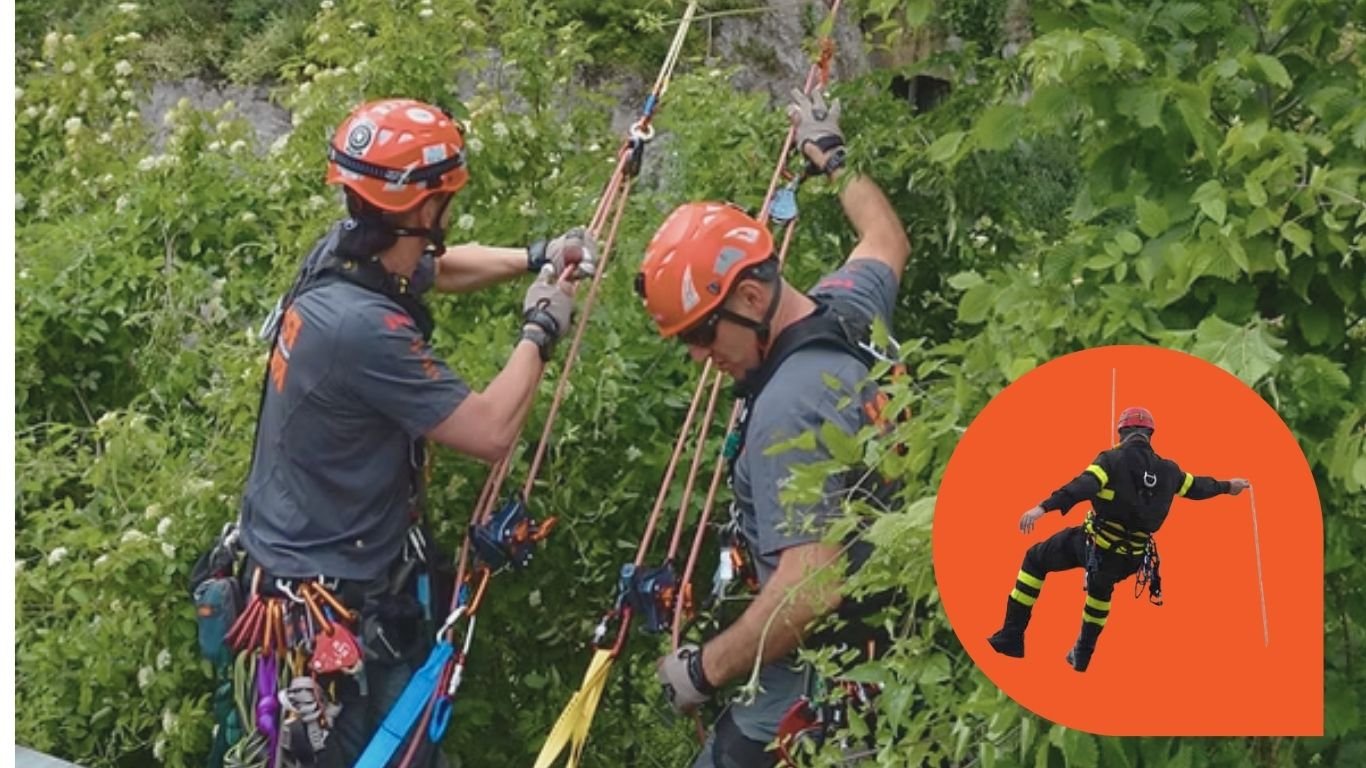OBJECTIVES
Upon completion of this lesson, you will become familiar with:
- Define the Ascending and Descending.
- List the nine materials and equipment that are used in Ascending and Descending.
- Describe the rescue methods of ascending and descending.
- Describe the Safety measures of Ascending and Descending.

Ascending and Descending in Rescue Operations
Definition
The rescuer climbs up through this technique to rescue the victim from high-rise buildings.
Ascending refers to the process of moving upward using specialized equipment, while Descending involves controlled downward movement, typically during rescue or evacuation operations. These techniques are crucial in high-angle rescues, confined space operations, and industrial rope access.
Materials and Equipment Used
The following are essential tools for ascending and descending operations:
- Ascender – A mechanical device used to grip the rope for upward movement.
- Descender – A friction device used for controlled descent.
- Karabiner – A metal loop with a spring-loaded gate for securing ropes and equipment.
- Full Body Harness – Provides support and safety during vertical operations.
- Figure of Eight – A descender shaped like the number “8” for rope control.
- Rope (minimum 100-meter length) – High-strength dynamic or static rope for support.
- Walkie-Talkie Set – Ensures communication between rescuers and command.
- Megaphone – Used for verbal communication in noisy environments.
- Rope Roller – Reduces friction and aids in smooth rope movement.
Rescue Method
The following steps outline the ascending and descending rescue process:
- The Incident Commander assigns duties to rescuers for height rescue operations.
- Ensure PPE is worn at all times.
- Select an appropriate anchor point and prepare two rope lines.
- A rescuer wears a harness and carries an ascender and descender.
- Attach one ascender to the waist hook of the harness and the second ascender to the right or left foot.
- Secure the safety line to the back of the rescuer.
- Another rescuer tightens the rope to ensure stability.
- Ascending Steps:
- (i) Stand on the foot with the ascender.
- (ii) Sit back gently, as the harness is hooked to the rope.
- Repeat these steps until reaching the target height.
- Descending Steps:
- Attach the descender to the waist hook.
- Position the body with straight legs for balance.
- Slightly push the lever to release the rope gradually.
- Descend smoothly and in control.
Safety Measures
To ensure safety during ascending and descending operations, follow these precautions:
- Always wear proper PPE, including:
- Helmet with strap
- Working leather gloves
- Goggles (optional)
- Face mask (optional)
- Knee and elbow pads
- Safety shoes
- Full body harness
- Safety belt or bowline for additional security
- Inspect the platform/tower before climbing; ensure it is stable.
- Mark a 2-foot danger zone around the platform. No one should stand here; use a walkie-talkie or kneel to communicate.
- Knot selection and application must be accurate and firm.
- Check all ropes and lines for proper attachment.
- Ensure ascenders and descenders are in good working condition.
- One ascender should be attached to the harness, and the other to the foot (ensure comfort).
- Always keep the rope tight—either by another rescuer or an anchor point.
- Maintain clear communication using radios; it is critical for team coordination.
- Lock all karabiners securely; carry a spare if needed.
- Be mindful of rope dressing when tying knots to prevent them from slipping.
By following these guidelines, rescuers can perform ascending and descending operations safely and efficiently, minimizing risks during high-angle rescues.
Mastering ascending and descending techniques is essential for safe and effective high-angle rescues. By using the right **equipment—such as harnesses, ascenders, descenders, and ropes and following strict safety protocols, rescuers can perform operations efficiently while minimizing risks. Proper PPE, secure anchor points, and clear communication are critical for success.
Whether evacuating victims from heights or conducting industrial rope access, these methods ensure controlled movement and stability. Continuous training and adherence to safety measures enhance rescue effectiveness, protecting both responders and those in need. Stay prepared, stay safe, and prioritize precision in every rescue mission

Emma Lee, an expert in fire safety with years of firefighting and Rescuer experience, writes to educate on arescuer.com, sharing life-saving tips and insights.
